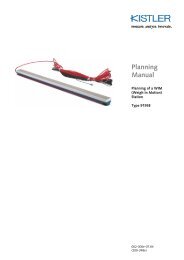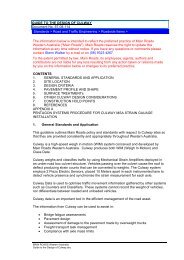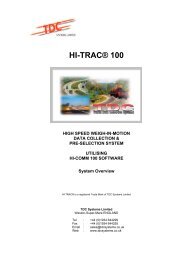Installation of Fixed Capacitive HSWIM Sensors
Installation of Fixed Capacitive HSWIM Sensors
Installation of Fixed Capacitive HSWIM Sensors
Create successful ePaper yourself
Turn your PDF publications into a flip-book with our unique Google optimized e-Paper software.
The following steps are taken when preparing a frame:<br />
Roughen the bottom <strong>of</strong> the frame with an angle grinder to assist with binding<br />
(Picture 18 on page 42).<br />
Carefully apply release agent to the inside <strong>of</strong> the frame. A beeswax based polish is<br />
recommended. The release agent prevents the epoxy sticking to the inside <strong>of</strong> the<br />
frame. Release agent must only be applied to the inside bottom and edges <strong>of</strong> the<br />
frame. Do not apply release agent to the inside <strong>of</strong> the pour holes and the outside <strong>of</strong><br />
the frame (Picture 19 on page 42).<br />
Clean the outside <strong>of</strong> the frame with acetone to remove any release agent that has<br />
accidentally contaminated these areas (Picture 20 on page 42).<br />
Block <strong>of</strong>f the 18, 10mm threaded holes to prevent the epoxy from filling them. Cover<br />
bolts lightly with release agent and temporarily screw them into the mounting holes<br />
(Picture 21 on page 42).<br />
Fix the installation and alignment-bars to the frame (Picture 22 on page 42).<br />
Align and set the frame in the recess. The frame must be between 2-3 mm lower<br />
than the road surface (the lowest point) (Picture 23 on page 42). Height control is<br />
achieved by adjusting the height screws on the installation brackets.<br />
On granular surfaces flat plates should be used under the adjusting screws to avoid<br />
the screws from settling into a local low point. When adjusting always work to the<br />
“average” pavement surface height.<br />
The width and breadth <strong>of</strong> the frame must be flush with the pavement (long<br />
and short direction). Use the bottom <strong>of</strong> the frame as reference point, not the<br />
frame sides.<br />
Mark the mounting frame’s support points after the frame has been moved. This<br />
would ensure that the frame is placed in the same position after height adjustments<br />
have been made and epoxy has been applied. (Picture 24 on page 43).<br />
An earth wire is attached to the bottom <strong>of</strong> the installation frame. This wire must be<br />
routed into the same slot as the sensor feeder cable. For this reason the sensor feeder<br />
slot must be deep enough to fit in the earth wire, sensor feeder and a minimum <strong>of</strong><br />
20mm sealant coverage.<br />
Diagram 7: Picture <strong>of</strong> the bottom <strong>of</strong> the installation frame showing the earth<br />
wire<br />
Some installation frames do not have a slot cut for the sensor feeder wire to exit. A slot<br />
has to be cut with a small angle grinder at the required corner. Ensure that no sharp<br />
edges are left that can damage the feeder cable. Cut the slot after the frame has been<br />
installed.<br />
MS001-96100-52 <strong>Installation</strong> <strong>of</strong> <strong>Fixed</strong> <strong>Capacitive</strong> <strong>HSWIM</strong> <strong>Sensors</strong> Issue5 1 March 2005<br />
14 / 56
















